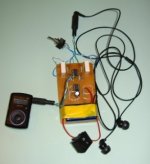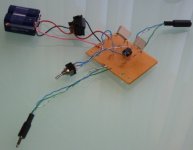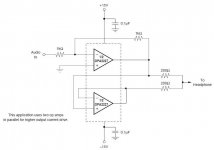Hey..
Im thinking of making a small portable headphone amplifier.
voltage source is going to be 2 lithiumbatteries 2X9v.
and i think the chip is going to be either a TL071CP or NE5534P..
wich would you recomend..
the ohm value of the headset's is 32ohm and 50.. the 50oms is a 3.5W... Source is a PC, mobilephone, and Ipod..
but i think that around 1watt of music it JUST fine..
i would like it to be as clear a possible..
any help..
another thing is it possible to parallelle opamps?.. i know that my opamps is around 500mW max.. and at 9v the headphones draws a little under 1 watt.. so two chips per channel or is that rubish, then rather make a transistor optputstage ?..
Im thinking of making a small portable headphone amplifier.
voltage source is going to be 2 lithiumbatteries 2X9v.
and i think the chip is going to be either a TL071CP or NE5534P..
wich would you recomend..
the ohm value of the headset's is 32ohm and 50.. the 50oms is a 3.5W... Source is a PC, mobilephone, and Ipod..
but i think that around 1watt of music it JUST fine..
i would like it to be as clear a possible..
any help..
another thing is it possible to parallelle opamps?.. i know that my opamps is around 500mW max.. and at 9v the headphones draws a little under 1 watt.. so two chips per channel or is that rubish, then rather make a transistor optputstage ?..
Sponkii said:voltage source is going to be 2 lithiumbatteries 2X9v.
No such voodoo.
Sponkii said:but i think that around 1watt of music it JUST fine..
1w through your headphones will leave you permanently deaf, if they don't fry first.
Sponkii said:...or is that rubish...
Yes, nearly everything you said.
Member
Joined 2003
Oh my, I recommend some (a lot) more research...
Start by reading datasheets, they include the max output current from which you can calculate power. Speaking of power, any reference you have made to power is completely out to lunch, to say the least.
If you want a good headphone amp, try something like LM4562 and a BUF634. See figure 4 and 5 in the BUF634 datasheet. But please, more research is necessary to understand what you are doing, and to get the most of your project.
Start by reading datasheets, they include the max output current from which you can calculate power. Speaking of power, any reference you have made to power is completely out to lunch, to say the least.
If you want a good headphone amp, try something like LM4562 and a BUF634. See figure 4 and 5 in the BUF634 datasheet. But please, more research is necessary to understand what you are doing, and to get the most of your project.
I have just build ''cmoy'' pocket headphone amp with OPA2132. I have used another opamp as voltage splitter to get +-4.5V from 9V battery.
It has all the power you need to drive almost any headphones. I also implemented bass boost circuit in the feedback loop with a switch to turn it off or on. It is still prototype but plays sweet with planty of power.
It has all the power you need to drive almost any headphones. I also implemented bass boost circuit in the feedback loop with a switch to turn it off or on. It is still prototype but plays sweet with planty of power.
Attachments
You can easily power your headphone chip amp from two 9V batteries to get +-9V
;look the photo of my first prototype.
1W of power would be too much; you need no more then 50mW for most headphones and you can get this power from OPA 132, OPA134, OPA227 and similar. I think TL071 would be good just to check if the amp is working properly. This chip is a poor performer.
Check this link: http://tangentsoft.net/audio/opamps.html
You will find there all the info of most opamps.
Do some research and type in Google cmoy and cmoy bass boost.
;look the photo of my first prototype.
1W of power would be too much; you need no more then 50mW for most headphones and you can get this power from OPA 132, OPA134, OPA227 and similar. I think TL071 would be good just to check if the amp is working properly. This chip is a poor performer.
Check this link: http://tangentsoft.net/audio/opamps.html
You will find there all the info of most opamps.
Do some research and type in Google cmoy and cmoy bass boost.
Attachments
Hi,
most headphones have a sensitivity between 90dB/mW and 100dB/mW.
If we take the lower sensitivity and apply a 1mW signal the phones will be very loud. I would suggest too loud for average level music.
Apply the normal +20dB overhead for transient peaks, that will give 110dB from just 100mW.
The 100dB phones will require only 10mW to achieve the same targets.
The difficulty is that headphones come in a very wide range of impedances and this makes a universal headphone amplifier more awkward to specify. High enough voltage for 300/600ohm phones.
High enough current for 8/16ohm phones.
But, with either, the design must be low noise, effectively -120dB relative to your required maximum power.
most headphones have a sensitivity between 90dB/mW and 100dB/mW.
If we take the lower sensitivity and apply a 1mW signal the phones will be very loud. I would suggest too loud for average level music.
Apply the normal +20dB overhead for transient peaks, that will give 110dB from just 100mW.
The 100dB phones will require only 10mW to achieve the same targets.
The difficulty is that headphones come in a very wide range of impedances and this makes a universal headphone amplifier more awkward to specify. High enough voltage for 300/600ohm phones.
High enough current for 8/16ohm phones.
But, with either, the design must be low noise, effectively -120dB relative to your required maximum power.
Sponkii said:and i think the chip is going to be either a TL071CP or NE5534P..
wich would you recomend..
If you use the NE5534 look for the audio type, i. e. NE5534A.
Did you check http://www.headwize.com/projects/cmoy2_prj.htm?
theAnonymous1
no not if it is rechargable.. if rechargable it is 10.8V...
the one watt req, is just to try it out, i sure know that is insane to crank it up to one watt with the headphones on your head..
DcibeL
the equations i have used is for eksampel from wiki for RMS voltage on sine waves.. so it might not be right..
- could you send me a link to a side with better equations?..
Igla
Ill give it a try look ..
..
no not if it is rechargable.. if rechargable it is 10.8V...
the one watt req, is just to try it out, i sure know that is insane to crank it up to one watt with the headphones on your head..
DcibeL
the equations i have used is for eksampel from wiki for RMS voltage on sine waves.. so it might not be right..
- could you send me a link to a side with better equations?..
Igla
Ill give it a try look
Sponkii said:no not if it is rechargable.. if rechargable it is 10.8V
There is no such thing as a single 9V or 10.8V lithium cell (rechargeable or not). To get 10.8V you need three lithium cells in series.
About connecting op-amps in parallel to increase the output current:
Connecting them straight in parallel makes no sense. Due to offsets and other non-idealities the op-amps will differ in opinion about what the output voltage should be, and you will get large currents flowing from one op-amp to the other. In the end, the op-amp with the highest current limit will win and the other(s) will just load it unnecessarily. In the worst case, different op-amps win in different parts of the output cycle, which due to the different offsets will cause a nasty distortion.
What you can do is give each op-amp its own feedback network and give each op-amp its own series resistor between its output and the headphone. These series resistors then prevent large currents between the op-amps.
Best regards,
Marcel van de Gevel
Connecting them straight in parallel makes no sense. Due to offsets and other non-idealities the op-amps will differ in opinion about what the output voltage should be, and you will get large currents flowing from one op-amp to the other. In the end, the op-amp with the highest current limit will win and the other(s) will just load it unnecessarily. In the worst case, different op-amps win in different parts of the output cycle, which due to the different offsets will cause a nasty distortion.
What you can do is give each op-amp its own feedback network and give each op-amp its own series resistor between its output and the headphone. These series resistors then prevent large currents between the op-amps.
Best regards,
Marcel van de Gevel
Re: lithiums
Well then, specifics go a long way in relaying your thoughts.
Sponkii said:theAnonymous1
i have never talked about singel cells..
i sure know that a singel cell only delivers 3.6v if rechargable.
and 3.0v if it is a regular cell..
not to mention different types of lithium cells that Li-ion/Lipo..
Well then, specifics go a long way in relaying your thoughts.
If more current is needed you could use parallel wiring from OPA227 datasheet.
Still, I would start with TL071 (they are cheap if something goes wrong) and two 9V batteries to get +-9V and non-inverting design with the gain of 6 (10kohm and 2kohm feedback resistors). You can't go simpler than that.
If the design meets your needs then swap opamp to OPA132 or OPA227.
Build the prototype (point to point wiring) and listen to it; then you will know if you need more power or bass boost or something else.
If small and portable is your choice (as you've mentioned in first post) then this is it.
Still, I would start with TL071 (they are cheap if something goes wrong) and two 9V batteries to get +-9V and non-inverting design with the gain of 6 (10kohm and 2kohm feedback resistors). You can't go simpler than that.
If the design meets your needs then swap opamp to OPA132 or OPA227.
Build the prototype (point to point wiring) and listen to it; then you will know if you need more power or bass boost or something else.
If small and portable is your choice (as you've mentioned in first post) then this is it.
Attachments
this look to easy to be true  ..
..
it it possible to to this kind of parallellign with moste op amps ?..
could i make the output resistor smaller for more outputcurrent at 9v
fx 120 then they se a 153Ohm load when driving small earplugs and 170ohm when driving my headphones..
it it possible to to this kind of parallellign with moste op amps ?..
could i make the output resistor smaller for more outputcurrent at 9v
fx 120 then they se a 153Ohm load when driving small earplugs and 170ohm when driving my headphones..
Hi Marcel van de Gevel
---Due to offsets and other non-idealities the op-amps will differ in opinion about what the output voltage should be----
Slightly off topic : this is the reason why I have some difficulties with the concept of complementary differential input pairs.
BTW, I very much like your designs published in Electronics World.
---Due to offsets and other non-idealities the op-amps will differ in opinion about what the output voltage should be----
Slightly off topic : this is the reason why I have some difficulties with the concept of complementary differential input pairs.
BTW, I very much like your designs published in Electronics World.
- Status
- This old topic is closed. If you want to reopen this topic, contact a moderator using the "Report Post" button.
- Home
- Amplifiers
- Chip Amps
- Amplifier for headphones



